An Improved Surface Treatment Process of 304 Stainless Steel Based on Low-Temperature Chromizing and Ultrasonic Vibration Extrusion
Abstract
:1. Introduction
2. Improved Surface Treatment Process Based on Low-Temperature Chromizing and Ultrasonic Vibration Extrusion
2.1. Low-Temperature Chromizing Process
- Sodium salt or potassium salt is selected as the primary solvent, and low melting point chromium salt is used as the auxiliary agent.
- Chromium powder or ferrochromium powder is used as the chromizing agent.
- The workpiece to be infiltrated, one of sodium salt or potassium salt, chromium salt and chromium powder or ferrochromium powder infiltrating agent are put in a closed container.
- The temperature is raised to a specific temperature which is kept for a particular time.
- Hydrogen is continuously injected into the closed container under a certain pressure during the insulation process.
2.2. Ultrasonic Vibration Extrusion Process
3. Experimental Setup
3.1. Principle of Ultrasonic Vibration Extrusion
3.2. Experimental Design
4. Experimental Results and Discussion
4.1. Analysis of the Surface Roughness and Hardness
4.2. Comparison with Previous Research
4.3. Analysis of Machined Surface Topography
5. Conclusions
- (1)
- The surface hardness of the chromizing and ultrasonic extrusion combined process and the ultrasonic vibration extrusion process are higher than the original surface hardness, and the surface hardness of the combined process is about 2.55 times higher than the ultrasonic vibration extrusion process.
- (2)
- Both the proposed method and ultrasonic extrusion reduce the surface roughness. However, the surface roughness of the proposed method is higher than that of the ultrasonic extrusion.
- (3)
- The optimized process parameters of the low temperature chromizing and ultrasonic extrusion composite process are spindle speed 240 rpm, feed 0.1 mm/r and static extrusion amount 40 μm. As a result, the processing stainless steel materials with high hardness and roughness is lower than Ra 0.8 μm.
Author Contributions
Funding
Institutional Review Board Statement
Informed Consent Statement
Data Availability Statement
Conflicts of Interest
References
- Park, J.H.; Kang, Y. Inclusions in stainless steels—A Review. Steel Res. Int. 2017, 88, 1700130. [Google Scholar] [CrossRef]
- Zhao, B.; Xu, G.X.; He, F. Present status and prospect of ultra-high strength steel applied to aircraft landing gear. J. Aeronaut. Mater. 2017, 37, 1–6. [Google Scholar]
- Dong, Z.; Li, Y.; Lee, B.; Babkin, A.; Chang, Y. Research status of welding technology of ferritic stainless steel. Int. J. Adv. Manuf. Technol. 2021, 118, 1–27. [Google Scholar] [CrossRef]
- Gardner, L. Stability, and design of stainless-steel structures—Review and outlook. Thin-Walled Struct. 2019, 141, 208–216. [Google Scholar] [CrossRef]
- Francis, R.; Byrne, G. Duplex stainless steels-alloys for the 21st century. Metals 2021, 11, 836. [Google Scholar] [CrossRef]
- Liu, L.; Fan, C.L.; Sun, H.Y. Research progress of alumina-forming austenitic stainless steels: A review. Materials 2022, 15, 3515. [Google Scholar] [CrossRef]
- Zhang, Q.; Xu, S.; Zhang, Z.Q. Residual stress and microhardness evolution induced by conventional and ultrasonic shot peening. Mater. Sci. Technol. 2022, 38, 436–443. [Google Scholar] [CrossRef]
- Meng, Y.; Deng, J.X.; Wu, J.X. Improved interfacial adhesion of AlTiN coating by micro-grooves using ultrasonic surface rolling processing. J. Mater. Process. Technol. 2022, 304, 117570. [Google Scholar] [CrossRef]
- Kumar, S.; Kumar, D.; Singh, I.; Rath, D. An insight into ultrasonic vibration assisted conventional manufacturing processes: A comprehensive review. Adv. Mech. Eng. 2022, 14, 16878132221107812. [Google Scholar] [CrossRef]
- Tian, H. Chromizing subsequent solid solution nitriding multiple process of 304 stainless steel. Heat Treat. Technol. Equip. 2006, 4, 29–32. [Google Scholar]
- Blaha, F.; Langenecker, B. Tensile deformation of zinc crystal under ultrasonic vibration. Sci. Nat. 1955, 42, 556. [Google Scholar]
- Rozner, A.G. Effect of ultrasonic vibration on coefficient of friction during strip drawing. J. Acoust. Soc. Am. 1971, 49, 1368–1371. [Google Scholar] [CrossRef]
- Hayashi, M.; Jin, M.; Thipprakmas, S. Simulation of ultrasonic-vibration drawing using the finite element method. J. Mater. Process. Technol. 2003, 140, 30–35. [Google Scholar] [CrossRef]
- Lucas, M.; Daud, Y. A finite element model of ultrasonic extrusion. J. Phys. Conf. Ser. 2009, 181, 012027. [Google Scholar] [CrossRef] [Green Version]
- Manousakas, I.; Lin, G.H.; Chang, S.J. Application of ultrasonic extrusion in the preparation of liposomes. In Proceedings of the 2010 4th International Conference on Bioinformatics and Biomedical Engineering, Chengdu, China, 18–20 June 2010; pp. 1–4. [Google Scholar]
- Bozdana, A.T.; Gindy, N.N.; Li, H. Deep cold rolling with ultrasonic vibrations—A new mechanical surface enhancement technique. Int. J. Mach. Tools Manuf. 2005, 45, 713–718. [Google Scholar] [CrossRef]
- Tsuji, N.; Tanaka, S.; Takasugi, T. Effect of combined plasma-carburizing and deep-rolling on notch fatigue property of Ti-6Al-4V alloy. Mater. Sci. Eng. A 2009, 499, 482–488. [Google Scholar] [CrossRef]
- Dong, Z.; Zhou, T.; Liu, J.; Zhang, X.; Shen, B.; Hu, W.; Liu, L. Effects of pack chromizing on the microstructure and anticorrosion properties of 316 L stainless steel. Surf. Coat. Technol. 2019, 366, 86–96. [Google Scholar] [CrossRef]
- Ruan, M.Y.; Peng, X.J.; Zhuang, F.J.; Zhu, X.Y. Study on fatigue behavior of plasma chromizing strengthening layer on biphasic titanium alloy. J. Mech. Strength 2021, 43, 442–446. [Google Scholar]
- Wang, Z.M.; Li, Q.D.; Wang, H.; Wang, H.L.; Hu, J.; Zhao, S.X. Effect of ultrasonic impact on the friction and wear properties of chromized layer of 65 Mn steel. Surf. Technol. 2021, 8, 1–11. [Google Scholar]
- Dong, Z.H. Research on the Anti-Corrosion Properties of Surface Chromizing Layer on 316 L Stainless Steel; Shanghai Jiao Tong University: Shanghai, China, 2020; pp. 45–48. [Google Scholar]
- Tang, X.G.; Dai, M.J.; Wei, C.B.; Kuang, T.C.; Lin, S.S.; Hou, H.J. Influence of solid chromizing doped with various rare earths on microstructures and properties of Cr-RE coatings fabricated by pack cementation. Surf. Technol. 2018, 47, 157–164. [Google Scholar]
- Zheng, J.X.; Liu, C.S.; Zhang, Y.M. Basic research on ultrasonic extrusion for 45 steel shaft. Key Eng. Mater. 2010, 455, 288–292. [Google Scholar] [CrossRef]
- Wang, H.Y. Research on the Ultrasonic Extrusion Strengthening Technology for Hollow Axle Material of High-Speed Train; Beijing Jiaotong University: Beijing, China, 2015; pp. 73–76. [Google Scholar]
- Zhou, H.; Zhang, J.; Yu, D.; Feng, P.; Wu, Z.; Cai, W. Advances in rotary ultrasonic machining system for hard and brittle materials. Adv. Mech. Eng. 2020, 11, 1687814019895929. [Google Scholar] [CrossRef] [Green Version]
- Zhu, Y.L.; Wang, Y.L.; Bian, F.L.; Hou, S.; Xie, J. Progresses on research and application of metal ultrasonic surface enhancement technologies. J. Mech. Eng. 2014, 50, 35–45. [Google Scholar] [CrossRef]
- Lou, Y.; Liu, X.; He, J.; Long, M. Ultrasonic-assisted extrusion of ZK60 Mg alloy micropins at room temperature. Ultrasonics 2018, 83, 194–202. [Google Scholar] [CrossRef] [PubMed]
- Zhang, C.H. Parameter Determination of Constitutive Model of 18CrNiMo7-6 and Theoretical Analysis and Simulation of Ultrasonic Rolling; Zhengzhou University: Zhengzhou, China, 2021; pp. 37–38. [Google Scholar]
- Zhou, Z.; Yao, C.; Zhao, Y.; Wang, Y.; Tan, L. Effect of ultrasonic impact treatment on the surface integrity of nickel alloy 718. Adv. Manuf. 2021, 9, 160–171. [Google Scholar] [CrossRef]
- Liu, Y. Research on the Theory of Ultrasonic Surface Rolling Processing and Mechanical Properties of Metal Surface; Tianjin University: Tianjin, China, 2012; pp. 33–37. [Google Scholar]
- Song, H.W.; Dan, J.Q.; Li, J.L. Experimental study on the cutting force during laser-assisted machining of fused silica based on the Taguchi method and response surface methodology. J. Manuf. Process. 2019, 38, 9–20. [Google Scholar] [CrossRef]
- Zhang, Q.; Cao, J.; Wang, H. Ultrasonic surface strengthening of train axle material 30CrMoA. Procedia Cirp 2016, 42, 853–857. [Google Scholar]
- Fang, S.; Zhang, Q.; Zhao, H.; Yu, J.; Chu, Y. The design of rare-earth giant magnetostrictive ultrasonic transducer and experimental study on its application of ultrasonic surface strengthening. Micromachines 2018, 9, 98. [Google Scholar] [CrossRef]




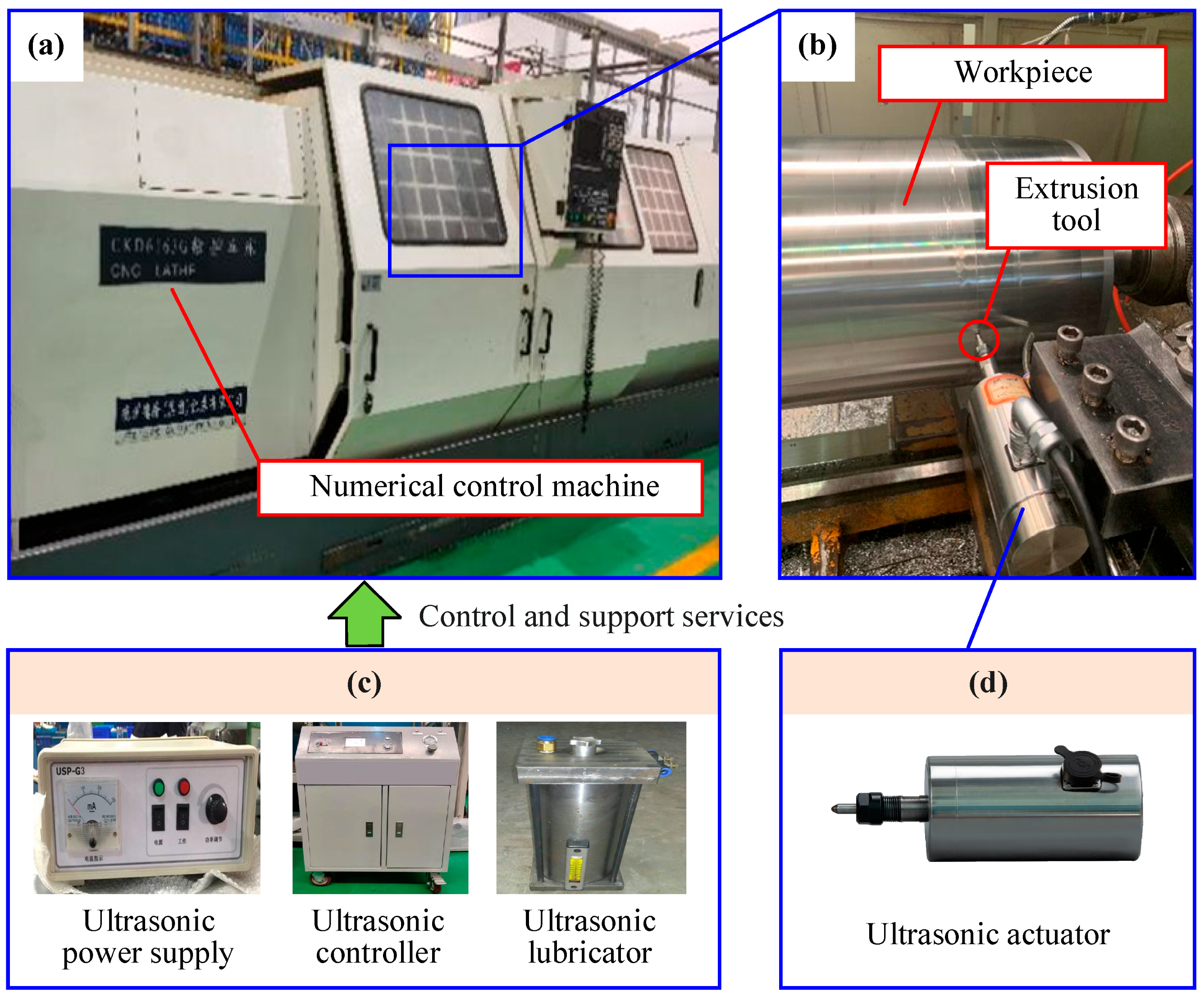
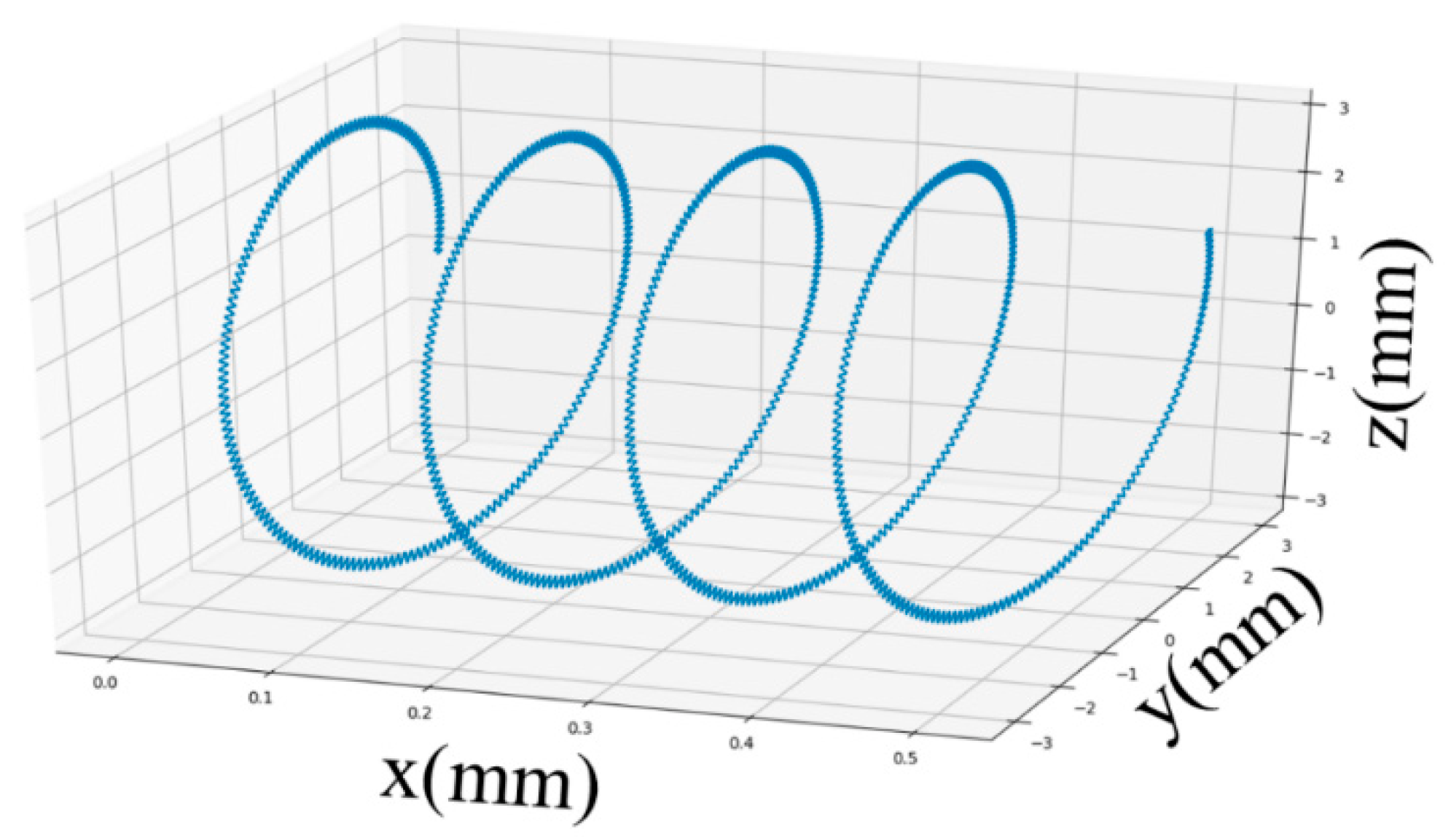
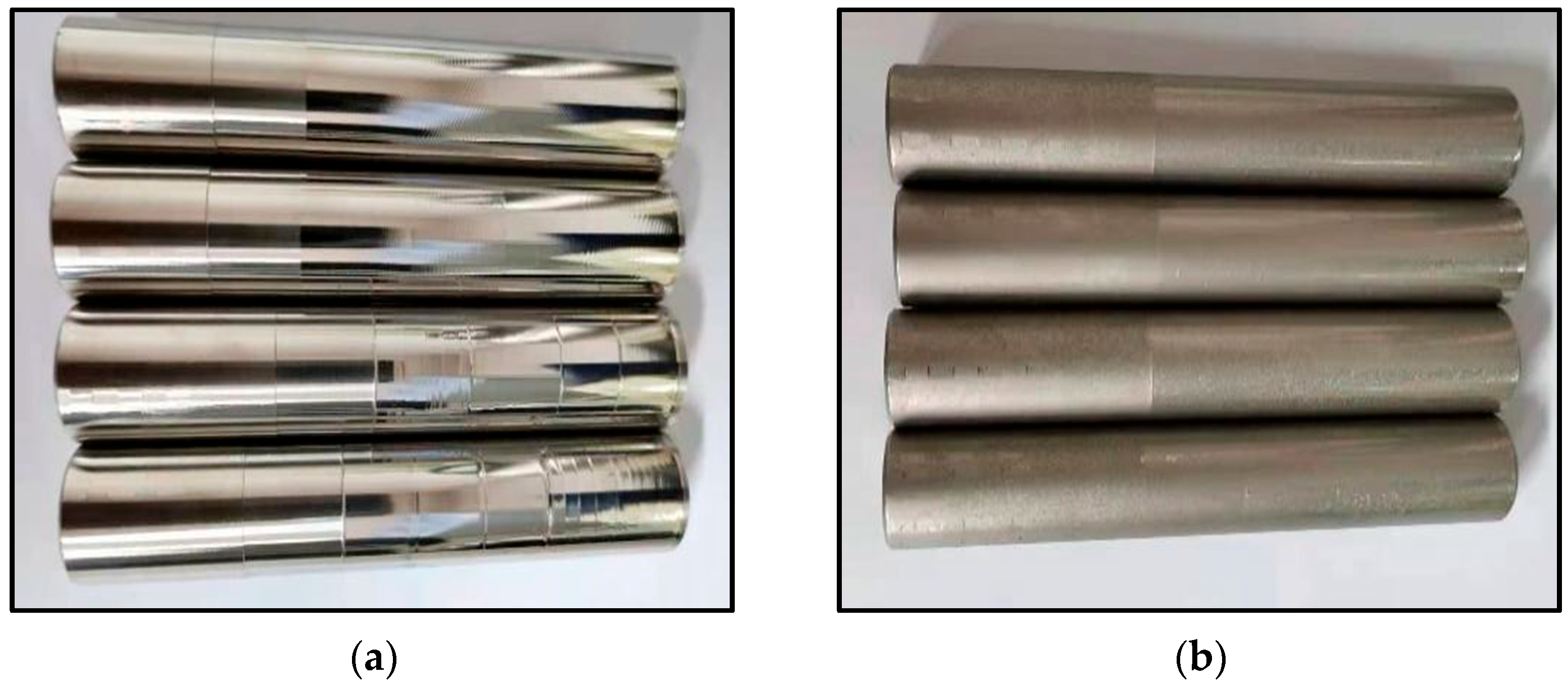
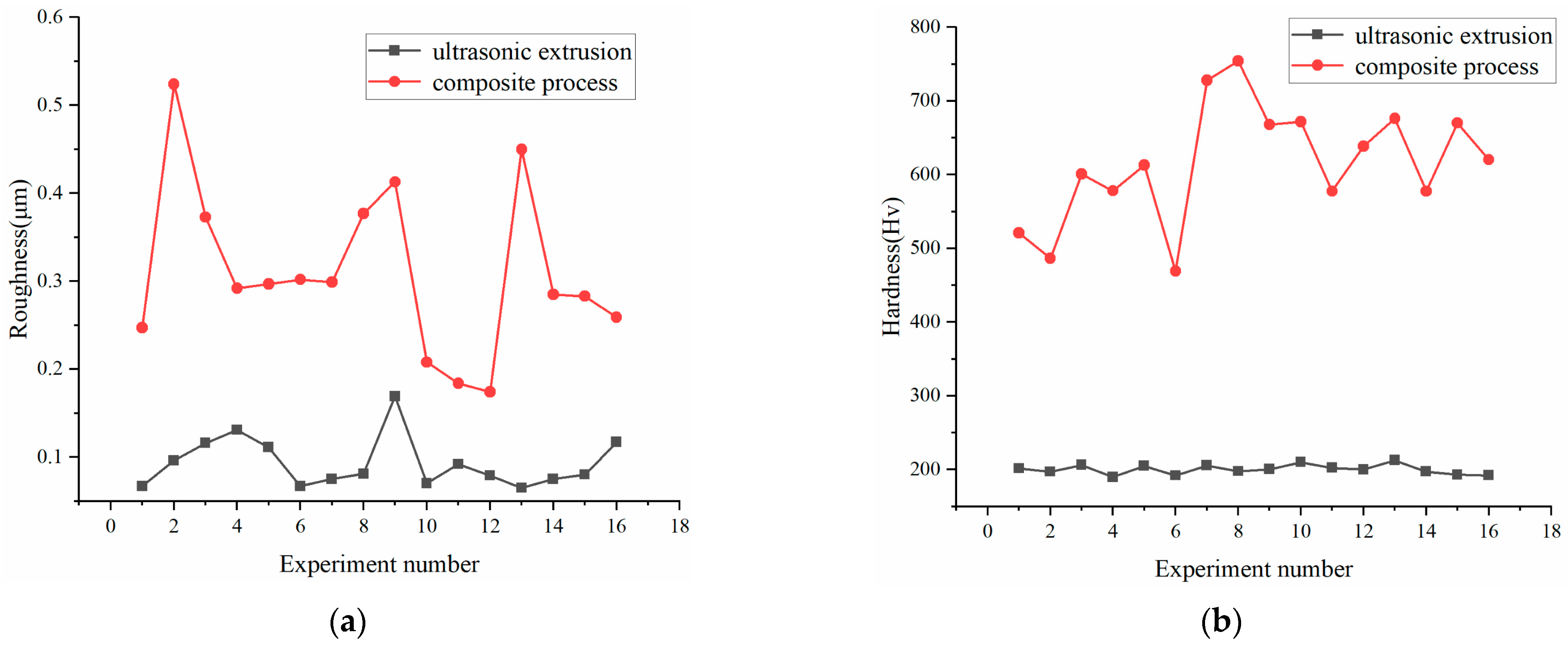

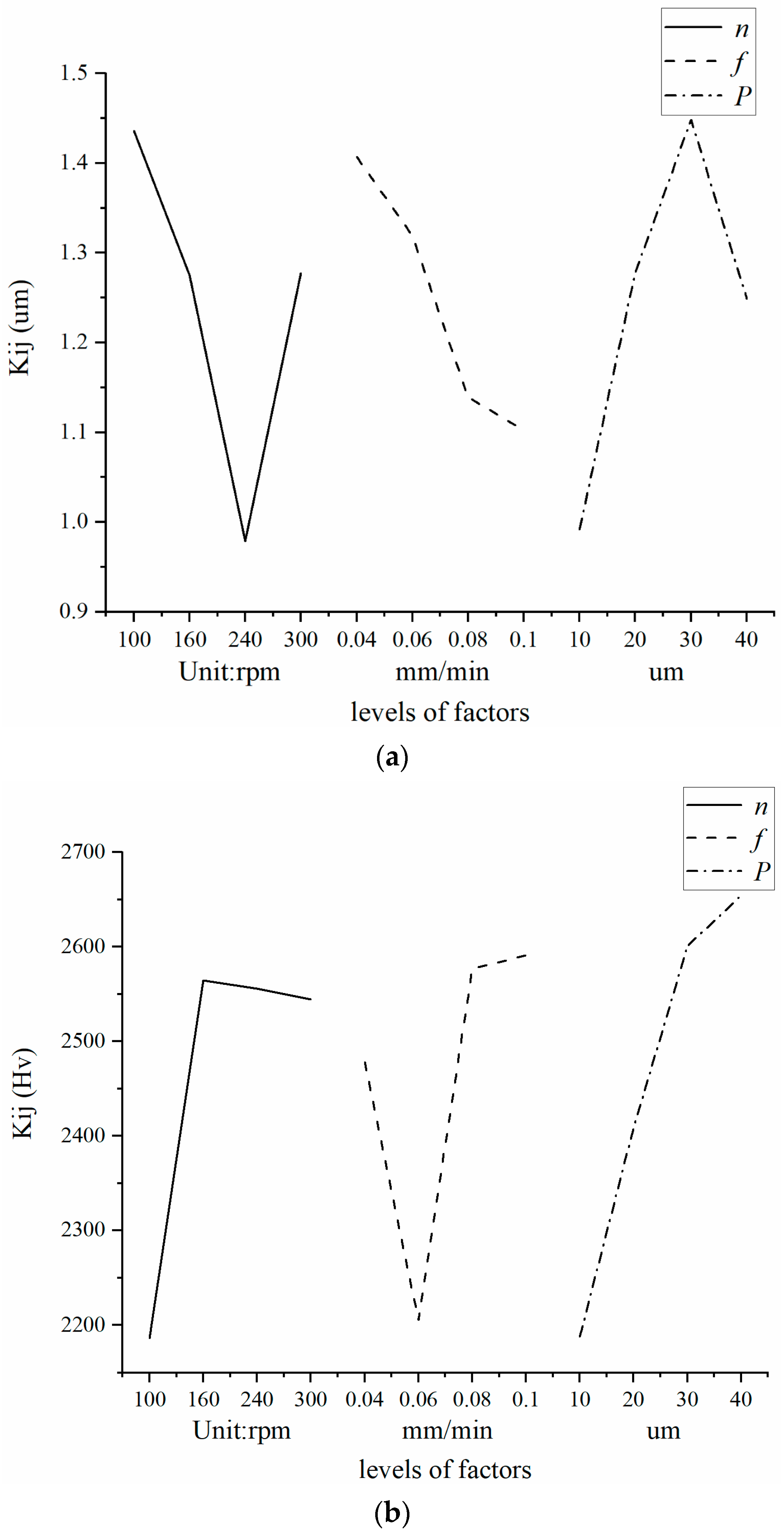

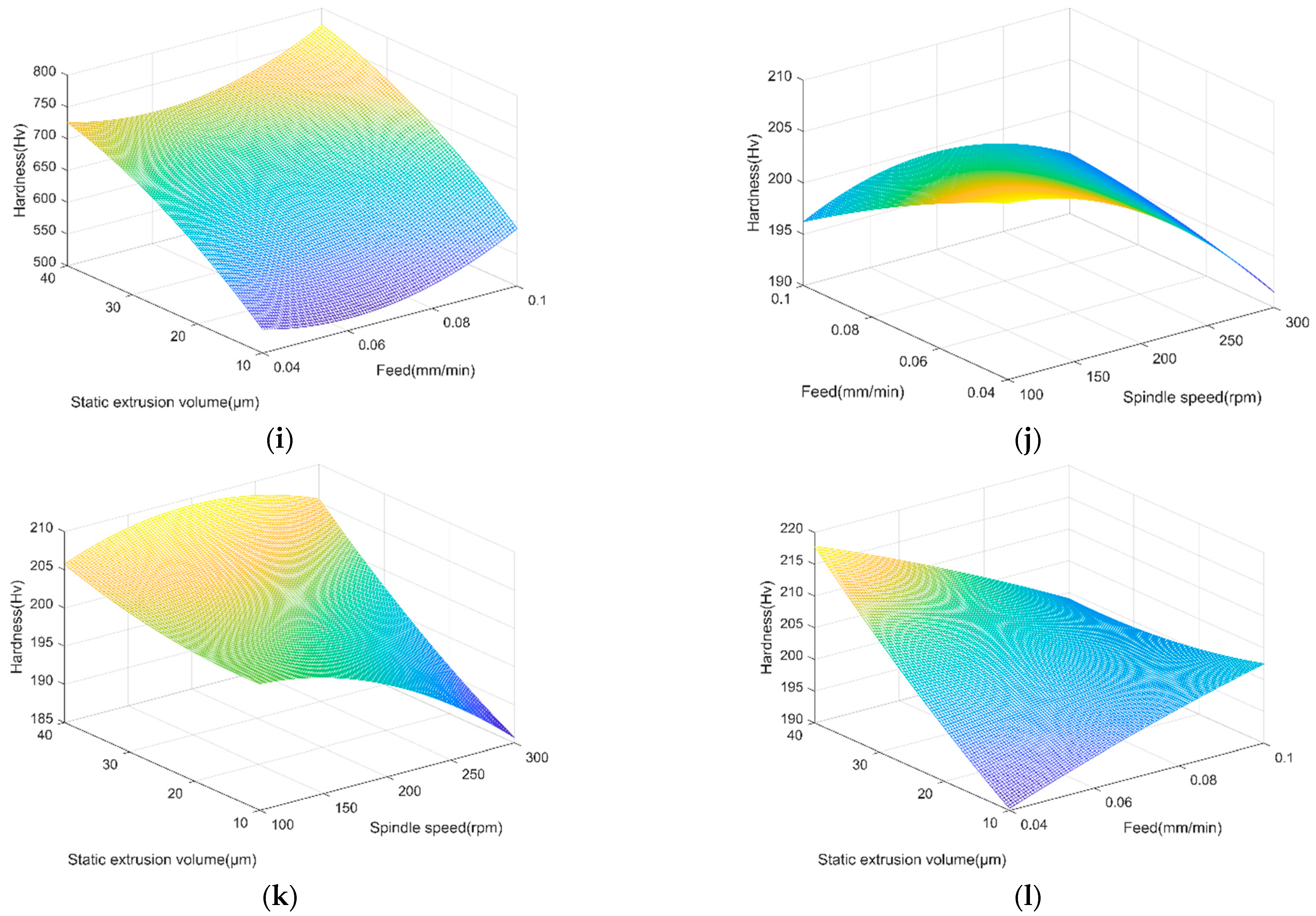


| Factor | (rpm) | (mm/r) | (μm) | |
|---|---|---|---|---|
| Level | ||||
| 1 | 100 | 0.04 | 10 | |
| 2 | 160 | 0.06 | 20 | |
| 3 | 240 | 0.08 | 30 | |
| 4 | 300 | 0.1 | 40 | |
| No. | Spindle Speed n (rpm) | Feed f (mm/r) | Static Extrusion Amount P (μm) | Roughness Ra (μm) | Hardness (Hv) | ||
|---|---|---|---|---|---|---|---|
| Composite Process | Ultrasonic Extrusion | Composite Process | Ultrasonic Extrusion | ||||
| 1 | 100 | 0.04 | 10 | 0.247 | 0.067 | 520.92 | 201.58 |
| 2 | 100 | 0.06 | 20 | 0.524 | 0.096 | 486.59 | 197.03 |
| 3 | 100 | 0.08 | 30 | 0.373 | 0.116 | 601.00 | 206.28 |
| 4 | 100 | 0.1 | 40 | 0.292 | 0.131 | 578.12 | 189.77 |
| 5 | 160 | 0.04 | 20 | 0.297 | 0.111 | 612.99 | 204.82 |
| 6 | 160 | 0.06 | 10 | 0.302 | 0.067 | 469.35 | 191.86 |
| 7 | 160 | 0.08 | 40 | 0.299 | 0.075 | 728.08 | 205.54 |
| 8 | 160 | 0.1 | 30 | 0.377 | 0.081 | 754.16 | 197.68 |
| 9 | 240 | 0.04 | 30 | 0.413 | 0.169 | 667.98 | 200.43 |
| 10 | 240 | 0.06 | 40 | 0.208 | 0.07 | 671.80 | 209.97 |
| 11 | 240 | 0.08 | 10 | 0.184 | 0.092 | 577.55 | 202.36 |
| 12 | 240 | 0.1 | 20 | 0.174 | 0.079 | 638.75 | 200.00 |
| 13 | 300 | 0.04 | 40 | 0.45 | 0.065 | 676.37 | 212.49 |
| 14 | 300 | 0.06 | 30 | 0.285 | 0.075 | 577.58 | 197.30 |
| 15 | 300 | 0.08 | 20 | 0.283 | 0.08 | 670.12 | 192.96 |
| 16 | 300 | 0.1 | 10 | 0.259 | 0.117 | 620.23 | 192.04 |
| Treatment | Factors | Spindle Speed A | Feed B | Static Extrusion Amount C |
|---|---|---|---|---|
| Surface roughness Ra | 1 | 0.41 | 0.412 | 0.343 |
| 2 | 0.334 | 0.308 | 0.366 | |
| 3 | 0.41 | 0.363 | 0.441 | |
| 4 | 0.337 | 0.408 | 0.341 | |
| Range R | 0.076 | 0.104 | 0.1 | |
| Surface hardness | 1 | 794.66 | 819.32 | 787.84 |
| 2 | 799.90 | 796.16 | 794.81 | |
| 3 | 812.75 | 807.14 | 801.68 | |
| 4 | 794.79 | 779.49 | 817.78 | |
| Range R | 18.09 | 39.83 | 29.93 |
| Evaluation Index | Factors | Spindle Speed A | Feed B | Static Extrusion Amount C |
|---|---|---|---|---|
| Surface roughness Ra | 1 | 1.436 | 1.407 | 0.992 |
| 2 | 1.275 | 1.319 | 1.278 | |
| 3 | 0.979 | 1.139 | 1.448 | |
| 4 | 1.277 | 1.102 | 1.249 | |
| Range R | 0.457 | 0.305 | 0.456 | |
| Surface hardness | 1 | 2186.64 | 2478.26 | 2188.04 |
| 2 | 2564.59 | 2205.32 | 2408.45 | |
| 3 | 2556.07 | 2576.75 | 2600.73 | |
| 4 | 2544.30 | 2591.26 | 2654.37 | |
| Range R | 377.95 | 385.94 | 466.33 |
Publisher’s Note: MDPI stays neutral with regard to jurisdictional claims in published maps and institutional affiliations. |
© 2022 by the authors. Licensee MDPI, Basel, Switzerland. This article is an open access article distributed under the terms and conditions of the Creative Commons Attribution (CC BY) license (https://creativecommons.org/licenses/by/4.0/).
Share and Cite
Cao, Y.; Zheng, L.; Fan, W. An Improved Surface Treatment Process of 304 Stainless Steel Based on Low-Temperature Chromizing and Ultrasonic Vibration Extrusion. Appl. Sci. 2022, 12, 11729. https://doi.org/10.3390/app122211729
Cao Y, Zheng L, Fan W. An Improved Surface Treatment Process of 304 Stainless Steel Based on Low-Temperature Chromizing and Ultrasonic Vibration Extrusion. Applied Sciences. 2022; 12(22):11729. https://doi.org/10.3390/app122211729
Chicago/Turabian StyleCao, Yansheng, Lianyu Zheng, and Wei Fan. 2022. "An Improved Surface Treatment Process of 304 Stainless Steel Based on Low-Temperature Chromizing and Ultrasonic Vibration Extrusion" Applied Sciences 12, no. 22: 11729. https://doi.org/10.3390/app122211729
APA StyleCao, Y., Zheng, L., & Fan, W. (2022). An Improved Surface Treatment Process of 304 Stainless Steel Based on Low-Temperature Chromizing and Ultrasonic Vibration Extrusion. Applied Sciences, 12(22), 11729. https://doi.org/10.3390/app122211729







